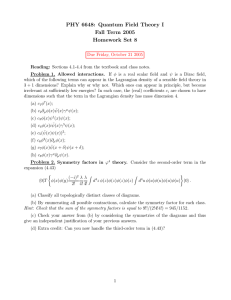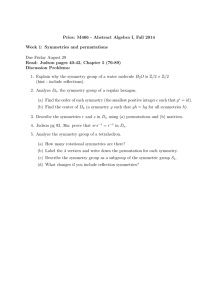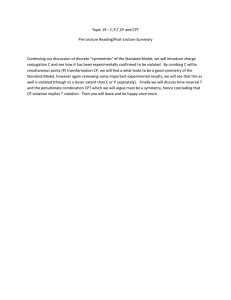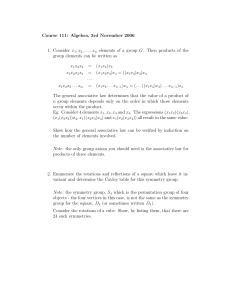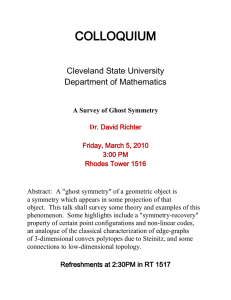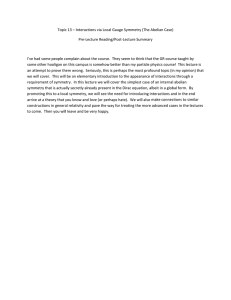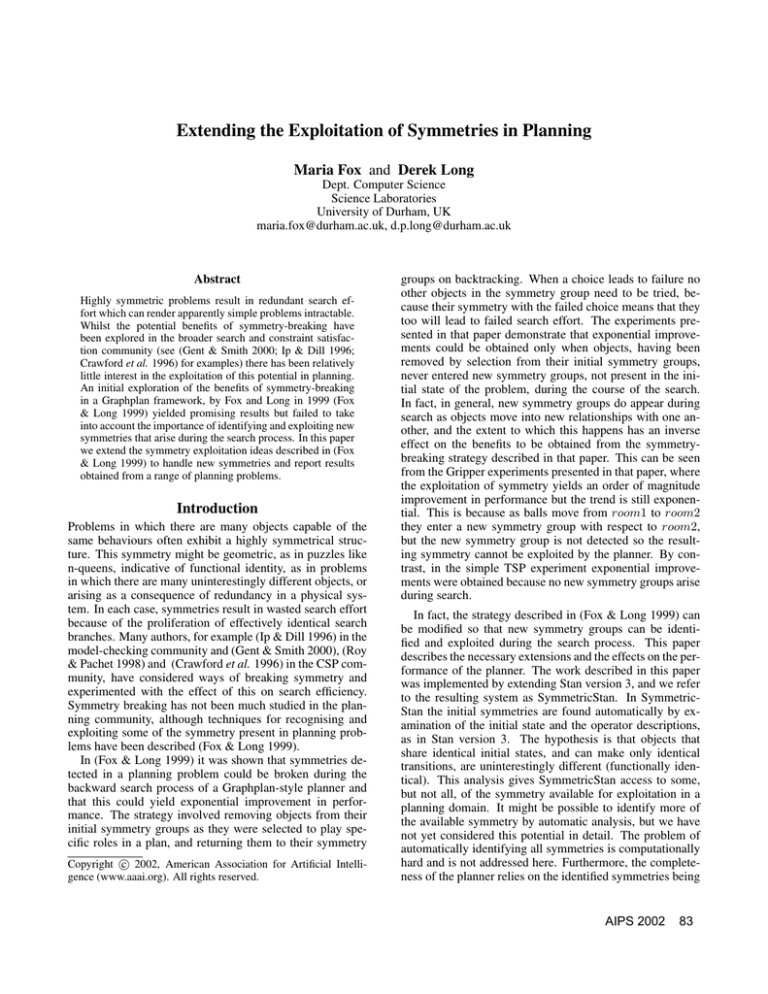
Extending the Exploitation of Symmetries in Planning
Maria Fox and Derek Long
Dept. Computer Science
Science Laboratories
University of Durham, UK
maria.fox@durham.ac.uk, d.p.long@durham.ac.uk
Abstract
Highly symmetric problems result in redundant search effort which can render apparently simple problems intractable.
Whilst the potential benefits of symmetry-breaking have
been explored in the broader search and constraint satisfaction community (see (Gent & Smith 2000; Ip & Dill 1996;
Crawford et al. 1996) for examples) there has been relatively
little interest in the exploitation of this potential in planning.
An initial exploration of the benefits of symmetry-breaking
in a Graphplan framework, by Fox and Long in 1999 (Fox
& Long 1999) yielded promising results but failed to take
into account the importance of identifying and exploiting new
symmetries that arise during the search process. In this paper
we extend the symmetry exploitation ideas described in (Fox
& Long 1999) to handle new symmetries and report results
obtained from a range of planning problems.
Introduction
Problems in which there are many objects capable of the
same behaviours often exhibit a highly symmetrical structure. This symmetry might be geometric, as in puzzles like
n-queens, indicative of functional identity, as in problems
in which there are many uninterestingly different objects, or
arising as a consequence of redundancy in a physical system. In each case, symmetries result in wasted search effort
because of the proliferation of effectively identical search
branches. Many authors, for example (Ip & Dill 1996) in the
model-checking community and (Gent & Smith 2000), (Roy
& Pachet 1998) and (Crawford et al. 1996) in the CSP community, have considered ways of breaking symmetry and
experimented with the effect of this on search efficiency.
Symmetry breaking has not been much studied in the planning community, although techniques for recognising and
exploiting some of the symmetry present in planning problems have been described (Fox & Long 1999).
In (Fox & Long 1999) it was shown that symmetries detected in a planning problem could be broken during the
backward search process of a Graphplan-style planner and
that this could yield exponential improvement in performance. The strategy involved removing objects from their
initial symmetry groups as they were selected to play specific roles in a plan, and returning them to their symmetry
c 2002, American Association for Artificial IntelliCopyright gence (www.aaai.org). All rights reserved.
groups on backtracking. When a choice leads to failure no
other objects in the symmetry group need to be tried, because their symmetry with the failed choice means that they
too will lead to failed search effort. The experiments presented in that paper demonstrate that exponential improvements could be obtained only when objects, having been
removed by selection from their initial symmetry groups,
never entered new symmetry groups, not present in the initial state of the problem, during the course of the search.
In fact, in general, new symmetry groups do appear during
search as objects move into new relationships with one another, and the extent to which this happens has an inverse
effect on the benefits to be obtained from the symmetrybreaking strategy described in that paper. This can be seen
from the Gripper experiments presented in that paper, where
the exploitation of symmetry yields an order of magnitude
improvement in performance but the trend is still exponential. This is because as balls move from room1 to room2
they enter a new symmetry group with respect to room2,
but the new symmetry group is not detected so the resulting symmetry cannot be exploited by the planner. By contrast, in the simple TSP experiment exponential improvements were obtained because no new symmetry groups arise
during search.
In fact, the strategy described in (Fox & Long 1999) can
be modified so that new symmetry groups can be identified and exploited during the search process. This paper
describes the necessary extensions and the effects on the performance of the planner. The work described in this paper
was implemented by extending Stan version 3, and we refer
to the resulting system as SymmetricStan. In SymmetricStan the initial symmetries are found automatically by examination of the initial state and the operator descriptions,
as in Stan version 3. The hypothesis is that objects that
share identical initial states, and can make only identical
transitions, are uninterestingly different (functionally identical). This analysis gives SymmetricStan access to some,
but not all, of the symmetry available for exploitation in a
planning domain. It might be possible to identify more of
the available symmetry by automatic analysis, but we have
not yet considered this potential in detail. The problem of
automatically identifying all symmetries is computationally
hard and is not addressed here. Furthermore, the completeness of the planner relies on the identified symmetries being
AIPS 2002
83
Figure 1: The process by which geometric symmetries can
be exploited in backtracking over queen positions in an nqueens puzzle (black dots are choices excluded by symmetries on backtracking).
solution preserving. Again, it is too hard to guarantee this
automatically so the guarantee must be provided off-line (it
is straightforward to prove that our notion of functional identity is solution preserving).
This paper is structured in the following way. We first
describe the technical problems of expressing and exploiting symmetries in a general search context. We consider
symmetry exploitation in the contexts of planning, solving
CSPs and constructing reachability analyses. We then describe the technical aspects of implementing a symmetry
exploitation mechanism that is able to identify and exploit
newly arising symmetries during the search process, and explain how this differs from the approach described in (Fox
& Long 1999). We then present results demonstrating that
our approach gives us exponential improvements in performance in highly symmetric domains, and we demonstrate
the improvements obtained over the results reported in (Fox
& Long 1999). Finally, we consider scope for future developments in symmetry exploitation in planning.
Exploiting Symmetries in Search
The simplest way of understanding the concept of symmetry
is in a CSP context in which the problem is expressed as a set
of variables each associated with a domain of values. Search
can be seen to take place in the space of partial assignments,
and the choices associated with a node correspond to the
values available for assignment to a particular unassigned
variable. In this context we can say that if two values in the
domain of V , vi and vj , are symmetric then failure of the
assignment of vi to V implies failure of the assignment of
vj to V . This observation justifies the pruning of the branch
corresponding to the choice of vj as soon as the choice of vi
fails.
When the assignment of some vi is made, to variable V ,
vi can no longer be seen as symmetric to the values it was
symmetric to prior to its selection. This symmetry can only
be regained when the choice is undone on backtracking. Furthermore, subsequent choices are made in the context of the
assignment of vi to V , so the only symmetries that can be
exploited when these choices are backtracked over are the
84
AIPS 2002
ones that are active in the context of the selection of vi . The
n-queens example presented in Figure 1 shows how symmetries change between contexts. Before any queens are placed
the board has horizontal, vertical and diagonal symmetries
(also some rotational symmetries, not depicted). When the
first queen is placed, in the origin, only the symmetry corresponding to the leading diagonal is active in the resulting
board position. The second queen is placed on the board
in this context. Now – suppose the resulting board position
cannot be developed to a solution. When the second choice
is backtracked over only the search branch corresponding
to the position reflected over the leading diagonal can be
pruned. When the first choice is backtracked over all of the
original symmetries can be exploited to prune search. As
can be seen in the figure, this results in the removal of four
choices for this first queen – the bottom right hand corner is
excluded by composition of the horizontal and vertical symmetries.
Gent and Smith (Gent & Smith 2000) discuss the nqueens problem as an example of one where symmetry
breaking can yield orders of magnitude gains in performance
in the production of all solutions given a specific n. They
explain how symmetries, hand-coded by the domain modeller, can be exploited to construct just one solution from
the equivalence class of solutions defined by the symmetries, and the other solutions extracted by application of the
symmetries to that one solution. One might expect an exponential improvement in performance to be demonstrated,
but in fact this is not obtained because of failure of the
strategy to maximise the potential for symmetry-breaking in
the search process. In the n-queens situation new symmetries not present in the initial board do not arise because the
empty board already contains all available symmetries in the
problem. However, the order in which variables are considered for assignment does affect the effectiveness with which
these symmetries can be exploited. For example, when the
first queen is placed on the board all symmetries will be
lost, unless the queen is placed on an axis (as in the figure), and never regained unless that choice is backtracked
over. However, the placement of the second queen can allow some symmetry to be recovered. For example, if the first
queen is placed at position (r2,c1) and the second at position
(r3,c4) then rotational symmetry returns to the board (rotation through 180 degrees). However, if the second queen is
placed in a different column then no symmetry will arise.
Gent and Smith observe that variable ordering can be significant in determining how much symmetry can be exploited
in the search for a CSP solution.
Planning domains typically reveal less geometric structure than puzzles of this nature, but the processes by which
symmetries are broken by the selection of choices and then
reinstated on backtracking are identical. Exploitation of
symmetry depends on the notion of functional identity:
Definition 1 In a planning problem, two objects are functionally identical if they do not appear explicitly in any operator schema for the domain and uniformly substituting each
for the other throughout the initial and goal states of the
problem yields an identical problem (modulo ordering of
propositions).
room1
room2
Figure 2: The initial state of a trivial instance of the Gripper
domain, in which all the balls and both grippers are respectively symmetric. The robot can move between the rooms
and the balls can be picked and dropped.
room1
be the identity permutation). A simple encoding of the nqueens problem as a CSP can be constructed in which the
variables correspond to column numbers and the values correspond to row numbers. The variables all share the same
domain and the assignment of a value to a variable corresponds to specifying the row for the position of the queen in
that column. Under this encoding horizontal symmetry can
be expressed as the composition of:
ri ↔ rn−i+1
with the identity permutation on variables. Vertical symmetry can be expressed as the composition of:
ci ↔ cn−i+1
room2
Figure 3: A Gripper state during search, in which some of
the balls have been moved to room2. The black balls form
a symmetric collection not present in the initial state.
Fox and Long (Fox & Long 1999) present the results obtained from the Gripper domain, depicted in Figure 2, in
which the balls are functionally identical (they all begin in
room1, end in room2 and are capable of being picked up
and dropped) and the two grippers are also functionally identical (they both start and end empty and are capable of holding and of being empty). Stan version 3 is capable of using
these symmetries to prune alternative ball and gripper selections during the search process (on the grounds that if a plan
to move all the balls to room2 cannot be found, by timepoint k, by picking up ball1, then no plan will be found, by
time point k, by picking up ball2). In this domain symmetries that are not present in the initial state do arise during
the search process. Figure 3 depicts a symmetry that arises
during the search process that cannot be exploited by Stan
version 3.
The newly arising symmetries can be automatically detected, at each state visited in the search process, by examining the configurations of objects that have lost their initial
symmetric relationships. Any objects in identical configurations in a given state will form a new symmetric group
within that state. Of course, the challenge is to do this efficiently, so that the benefits of the pruning of symmetric
search branches is not undermined by the cost of finding
these branches in the first place. In the next section the
precise means by which this analysis is performed in SymmetricStan will be described. Before progressing to that description it is necessary to provide a more formal definition
of what is meant by a symmetry, and of how symmetries can
be identified from functional identities in the initial state of
a problem.
It is convenient to define a symmetry as a composition of
permutations on values and on variables (one of which may
with the identity permutation on values. Gent and Smith use
a more flexible interpretation of a symmetry (any one-toone mapping that is solution-preserving) but this is highly
permissive and prevents the exploitation potential of taking a group-theoretic view of symmetries. Indeed, using
the definition of symmetries as permutations closed under
composition it is possible to generate the full collection of nqueens symmetries from just one rotation and one reflection,
whereas using Gent and Smith’s definition it is necessary to
specify all of the symmetries by hand. The permutationsbased definition also emphasises the relationship between
symmetries in search and symmetry groups in the grouptheoretic sense – a relationship that might offer further support for insights into the exploitation of symmetry in search.
It is not a trivial step to see how the symmetries obtained
from functional identity in a planning problem can be expressed as permutations in this way. In fact, the permutations exist only implicitly in Stan version 3 and in SymmetricStan. They can be explicitly obtained by first identifying
the collections of functionally identical objects in the initial
state. These collections can then be used to generate all of
the symmetric propositions and symmetric actions defined
by the domain description. Taking again a CSP view, the
propositions (subscripted by time identifiers to indicate the
points at which they would be considered for assignment
during the search process) can be taken to be the variables
in the problem and the actions (again subscripted by time
to indicate when they could be assigned) can be taken to be
the values. Then permutations on the values can be formed
by pairwise swaps, throughout the current assignment, of
time-subscripted actions based on the symmetries between
the objects they manipulate. For example, if ball1 and ball2
are functionally identical, and lef t and right are functionally identical, then
pickupk (ball1, lef t, room1)
can be swapped with
pickupk (ball2, lef t, room1)
and
pickupk (ball2, lef t, room1)
can be swapped with
pickupk (ball2, right, room1)
AIPS 2002
85
(where k is the time step at which the action is applied). By
composing these permutations it can be seen that
pickupk (ball1, lef t, room1)
can be swapped with
pickupk (ball2, right, room1)
(the rooms are not functionally identical because they start
and end in different states). These pairwise swaps result in
the symmetric assignments that need not be considered during search if a particular value selection leads to failure.
It is important to observe that the exploitation of symmetry as described here is not dependent on the use of backtracking search. The processes described here can be implemented successfully in a forward-chaining reachability
analysis simply by using a record of which symmetric alternatives have been tried to eliminate choices at each level
in the forward search. Figure 4 shows how alternatives can
be quickly eliminated in the 4-queens problem. The choices
(open circles) rule out some spaces due to the rules of the
puzzle (black circles). However, when a choice is tried
and the branch it opens up has been explored, then symmetric choices (concentric circles) can be eliminated from
the search space. Placement of the second queen in the top
branch of the search space leads to failure, but it can also
be used to eliminate the symmetric placement of a queen in
the third column, as shown. Similarly, after failure with the
first queen placement, the four corner positions can all be
eliminated by symmetry in the subsequent search.
Recovering New Symmetries in
SymmetricStan
The potential for new symmetry states to arise during the
search process in the solution of many planning problems
means that the exploitation strategy described in (Fox &
Long 1999) has to be extended to gain the full benefits of symmetry-breaking. In Stan version 3 the standard GraphPlan-style (Blum & Furst 1995) backward search
through the plan graph was modified by the addition of two
data structures, one level-independent, called brokenSym,
which recorded whether objects were in or out of their initial symmetry groups and one level-dependent, called triedGroups, which recorded which collections of symmetric alternatives had effectively been tried once a choice had been
tried and had failed. BrokenSym could be level-independent
because every object that started in a symmetry group in the
initial state could, from then on, only be either in that group
or out of it. Because of this the brokenSym record could be
implemented as a boolean vector with one entry per domain
object. The triedGroups structure was level-dependent because failure of a particular action choice at layer k does not
obviate the need to consider a symmetric equivalent at layer
k+1 (hence the need to subscript actions with level numbers
in the representation of the symmetries).
The behaviour displayed by Stan version 3 is that, as
choices are made in the search process, a decreasing amount
of symmetry remains to be exploited. Since no symmetries not present in the initial state are discovered during the
86
AIPS 2002
search process this tends towards an exponentially worsening trend in performance. SymmetricStan extends the behaviour of Stan version 3 by making it possible to identify
the important new symmetries as they arise during search.
This is achieved as described in the following paragraphs.
The description given here is presented in terms of the modifications that need to be made to a Graphplan-style backward search of a plan graph. However, the underlying strategy for recording and exploiting the symmetry status of objects throughout the search process of a planner is identical
in other planning architectures and can be implemented in a
way similar to that described here.
In SymmetricStan, the data structure recording the membership of objects in symmetry groups is no longer levelindependent. Objects are no longer either in or out of their
initial groups, they might move between several different
groups throughout the search process. This membership pattern is level-dependent because objects make transitions between groups as a consequence of making transitions between states. We require brokenSym to record, for each object, whether it is in or out of the symmetry group that it
belonged to before entering the current layer. Thus, if ball1
was in the symmetry group of balls in room1 at level k, and
the action of picking up ball1 is performed at level k, then
ball1 can be recorded as having left its symmetry group at
level k − 1. A separate data structure, symRecords, maintains the symmetry group associated with each domain object. This can be consulted at any time in order to discover
what symmetry group a given object belongs to at a given
layer in the graph.
SymRecords and brokenSym are in a close relationship
with one another. At each layer, li , in the graph brokenSym
is consulted to ascertain which objects have left a symmetry
group in the transition to li . For each such object, o, the collection of active propositions at li is scanned to identify the
propositions that refer to o. These propositions, with references to o removed, are referred to as hulls for o. For example, the proposition (at ball1 room2) produces the hull (at *
room2) for the object ball1. The collection of hulls associated with o can be used as an index into an associative array
containing the existing symmetry groups and o can then be
correctly associated with its current symmetry group. This
array can be maintained in a level-independent way. The
hull-construction phase, and the identification of symmetry
group membership for each object, is done when all actions
at li have been selected.
A subtlety arises when concurrent activities refer to the
same object. The first concurrent action selected will cause
the object to leave its symmetry group. The second concurrent action selected will not affect whether the object is
in or out of a symmetry group because the object will have
already had its symmetry broken by the first action. If the
second action is undone, by backtracking, the symmetries of
the object will not be restored – indeed the object symmetries will only be restored if the first of the concurrent actions
is backtracked over. In this way, a collection of concurrent
actions is handled as a single package of actions on the object. The symmetry of the object is affected by selection
and de-selection of the whole package, although the order in
Symmetric choice
eliminated
Figure 4: The first two moves in the 4-queens problem, eliminating symmetric alternatives (and alternatives ruled out by the
rules of the game) in a forward-chaining search. As soon as a column cannot be filled the branch fails.
which the actions are selected determines which action has
the symmetry-breaking effect of the package on that object.
The final data structure to consider is the triedGroups
structure. In Stan version 3 triedGroups was implemented as
an array of the outer shells of matrices, one for each action
symmetry group, each one having dimensions corresponding to the number of potentially symmetric arguments of the
actions in that symmetry group. So, in the Gripper example,
since balls and grippers both form object symmetry groups
in the initial state, but rooms do not, the action symmetry group to which pickup(ball1,left,room1) belongs yields a
two-dimensional matrix with balls along one axis and grippers along the other. There are as many columns and rows
as there are balls and grippers respectively, with each column label corresponding to a single ball and each row label
corresponding to a single gripper. An extra column and row,
labelled (∗, ∗) is supplied to represent the symmetry groups
for balls and for grippers, respectively. In the matrix entry
for the pickup action group at layer k, a mark in the cell
corresponding to (lef t, ∗) means that all balls have effectively been picked up in the left gripper (that is: the attempt
to pickup ball1 in the left gripper failed to reach a solution
by layer k, so no other pickup actions using the left gripper
need be considered at this layer). A mark in (∗, ball1) means
that all grippers have effectively been tried on ball1, at layer
k, and a mark in (∗, ∗) means that no other pickup actions
need be tried at layer k. In Stan version 3 the inner cells in
the matrices were of no interest, since they corresponded to
specific instantiations of the associated action. For example,
a mark in (lef t, ball1) would simply assert that the attempt
to pickup ball1 in the left gripper had been tried. This yields
no useful pruning information so these cells were not stored.
In SymmetricStan the triedGroups structures have a more
sophisticated interpretation. Each layer in the graph still
maintains an array of matrices corresponding to the action
symmetry groups, and each matrix has dimensions determined by the number of potentially symmetric arguments.
However, in SymmetricStan the columns and rows of the
matrices are labelled by representatives of symmetry groups
which need not be singletons as in the matrices in Stan version 3. Because the column and row labels now refer to
symmetry groups the inner cells of the matrices become important: a mark in (lef t, ball1), for example, means that all
balls currently symmetric to ball1 have effectively been tried
in all grippers symmetric to the left gripper. Figure 5 depicts
this situation. It can be observed that the triedGroups structure is very similar in organisation to that in Stan version 3,
but that the way it is interpreted is different and its correct
use relies upon the correct maintenance of the associative
array associating objects with symmetry groups throughout
the search process.
Figure 5 should be read in the following way: the object b1 loses its symmetry as the search enters layer k of the
graph. Its new symmetry status is identified by the construction of its hulls and this process identifies b1 as belonging
to a symmetry group also containing b3 and b5. The ball b1
is taken to be the representative for this group. There is no
significance in its selection – any member ball can play this
role. It can now be seen that a mark in the cell corresponding to (lef t, b1), in the triedGroups matrix for the pickup
actions, is made when the action pickup(b1,left,room1) is
tried and fails. Since b1 is the representative for the group
also containing b3 and b5, the same cell would be marked if
pickup(b3,left,room1) had been tried instead, or even if the
pickup had been made using the right gripper (since left is
the representative for the group containing both the left and
right grippers). The matrices in triedGroups contain entries
for all potentially symmetric objects, even though many of
these entries will not be used. This is because the matrices are constructed before it is known which objects will be
representative of the symmetry groups available at the corresponding layers.
AIPS 2002
87
tried b1, b3 and b5 in both
grippers at layer k
b1
triedGroups
b1 b2
left
SymRecords
b3
b4
b5
left
b3
b5
right
*
b2
right
b4
b1 leaves its
symmetry
group on
entry to
layer k
link to sym record
through associative
array
hulls for b1
hulls define new symmetry group for b1
layer k
Figure 5: The triedGroups matrix for pickup actions at layer k, indicating that all balls symmetric to b1 have been tried in all
grippers symmetric to the left gripper.
The Logical Impact of Exploitation of
Symmetry
We now briefly review the effects that exploitation of symmetry can have in the planning framework. Soundness is the
most critical property and it is preserved by the mechanisms
we have described.
Theorem 1 Exploitation of symmetry to reduce search in a
planning architecture preserves soundness.
The proof of this result is straightforward, since the
exploitation of symmetry only ever leads to pruning of
branches in the search space, never introduction of new
branches. Therefore, a sound planner will remain sound if it
is modified to exploit symmetry.
Completeness is a more difficult issue. If we consider
the general idea of reduced search through exploitation of
symmetry we can make the following claim:
Theorem 2 If two objects, a and b, are functionally identical, then in any valid plan, P [a], which uses a and not b,
substitution of b for a yields a valid plan. If P [a, b] is a valid
plan that uses both objects, then P [b, a], in which a and b
are exchanged, is also a valid plan.
The proof of this result follows directly from the definition of functional identity. The result provides the foundation for claims for completeness:
Theorem 3 Let the expression C[x] denote a sequence of
choices made by a planner leading from its initialised state
to some node in its search space, with the planning domain
object, x, playing some role in that sequence (typically as
an argument in one or more actions selected for addition to
the plan).
If a planner prunes search branches that extend a sequence of choices made in the planning process C[a], when
it is known that no extension of choices C[b] leads to a plan
(where C[b] is the same sequence of choices except with b
88
AIPS 2002
substituted for a throughout), and a and b are functionally
identical, then this pruning cannot remove a plan from the
search space.
The proof of this result follows from the previous result.
We sketch the proof here: if a plan P [a] were to exist in the
search space extending a pruned branch, then P [b] would
be a plan and this would necessarily lie in the extension of
C[b], contradicting the premise that no such plan exists. If
a plan P [a, b] were to exist in one of the pruned branches,
then P [b, a] would similarly appear in the extension of C[b],
again leading to contradiction.
In our implementation we exploit symmetry more aggressively. A GraphPlan architecture typically favours no-ops
during planning, in order to reduce redundant activity at
each layer of the search. This means that choices for nonno-op achievers for goals at a layer are propagated starting
with the last goal considered at each layer, with all preceding goals achieved by no-ops. Only as search fails to identify
a plan will further non-no-op actions be selected for earlier
goals in the layer. A consequence of this is that opportunities to exploit symmetry could be seriously unndermined
if no-ops are treated as standard actions, removing symmetry from the objects to which they refer and changing the
search context as they are introduced. To avoid this, we treat
no-ops differently, as though they have no significance as
choice points. The impact of this is to grant exploitation
of symmetry much greater power in reduction of redundant
search, but at a different cost: it is no longer possible for
a layer to hold two or more symmetric actions to achieve
symmetric goals if there is a no-op for each of those goals
in the same layer. This causes plans to become sequentialised, forcing symmetric steps into different layers. Thus,
we sacrifice complete search over parallel plan structures,
but retain completeness for sequentialised plans. Alternative
mechanisms are possible, but our experiments so far have
suggested that attempts to preserve parallel completeness are
difficult to combine effectively with the standard GraphPlan
search strategy supplemented with symmetry pruning.
Airlock
Results
Figure 6: The Airlock domain. Opening a door seals the
previously opened door permanently closed.
1e+06
SymmetricSTAN
STAN v3
100000
10000
Time (Milliseconds)
We have conducted a range of experiments to investigate the
effects on planner performance of the extensions described
in the previous sections. We compared Stan version 3 with
SymmetricStan in order to discover the impact of exploiting symmetry groups that are not present in the initial state
of a problem but arise during the search process. In order
to dispel the concern that symmetries might cause less significant problems for forward searching planners we experimented with FF (Hoffmann & Nebel 2001) to see to what
extent its behaviour is sensitive to problem symmetries. All
experiments were performed under Linux on a PC with 1Gb
memory and a 1.4MHz Intel processor. We used FF version
2.2. All times for SymmetricStan and Stan version 3 include
the preprocessing time spent on identifying functional identities.
Our first experiment compared Stan version 3 and SymmetricStan on a range of problems from the Gripper domain.
These results are shown in Figure 7. As can be seen, Stan
version 3 can solve the first five problems, the largest of
which contains 12 balls. Performance is degrading by a factor of about 20, leading us to conclude that Stan version 3
would require in the order of 64 days to solve the 14 ball
problem. SymmetricStan solves the whole problem set, to
optimality, exhibiting only a quadratically growing increase
in requirements (in the log-scaled graph the downward slope
of the SymmetricStan curve indicates a polynomial rate of
increase).
Stan version 3 already exhibits significant performance
improvements, in domains containing symmetry, over raw
Graphplan, indicating that the Graphplan search strategy,
which attempts to find a plan at every level from the fixpoint layer to the solution layer is sensitive to symmetry and
performs badly when there are many redundant alternatives
to explore and the fix-point is many layers away from the
solution layer (this is the case for the Gripper domain). By
contrast, heuristic forward searching planners, such as FF,
are unaffected by symmetries in problems where the heuristic value of a state is close to its actual value. In solving
these problems FF never has to backtrack into a state from
which it would be forced to perform a breadth-first search of
a large plateau. However, Hoffmann (Hoffmann 2001) has
shown that the heuristic function used by FF produces good
estimates only in relatively simply structured problems. As
Hoffmann shows, the Gripper domain is simply structured
and FF is able to solve arbitrarily large Gripper problems
with linear increase in performance requirements.
This does not in any way undermine the importance
of symmetry exploitation, as our next experiment demonstrates. In problems where the heuristic function used by FF
is not able to provide good estimates of value, the ability to
handle symmetries could significantly reduce the sizes of the
plateaus that would need to be explored on backtracking.
We constructed the Airlock domain as an example of a
highly symmetric domain that FF is unable to solve for the
reasons described above. Airlock is an extended version of
1000
100
10
1
0
2
4
6
8
10
12
Problem Number
14
16
18
20
Figure 7: Comparison of Stan version 3 and SymmetricStan
on Gripper problems (log-scaled).
the Gripper domain in which there is a chain of rooms connected by doors. Opening a door causes the last door to be
irrevocably sealed (so the doors are one-way). The last room
is connected by a door to an air-lock connected to the first
room. The problem is to transport all the cargo stored in
the first room into the last room. FF cannot easily solve this
problem because it is fooled, by the presence of the airlock,
into concluding that the problem remains solvable if the first
item of cargo is moved into the last room before any other
items are moved. In fact, the only solution is to move all
of the cargo into the adjacent room and then keep moving
the cargo room by room until the last room is reached (the
airlock is never used). To find this solution FF is forced into
performing a breadth first search of all of the orders in which
the cargo items could have been transported. The Airlock
domain gives rise to many new symmetries during search every one of the rooms in the chain provides the opportunity for a new symmetric collection of cargos. FF cannot, of
course, exploit this feature, but SymmetricStan can.
Figure 8 presents the data we collected for the Airlock
problem. It can be seen that, although FF performs well (in
terms of time consumption – plan quality is quite poor) on
small Airlock problems it scales very badly. The graph is
log-scaled, and the upward trend of the FF curve therefore
indicates that FF’s performance requirements grow superexponentially with the increase in instance size (measured as
the number of cargos to be transported). FF was terminated
on the penultimate problem (9 cargos) having exhausted
available memory. By contrast, SymmetricStan solved all
of the problems presented, to optimality, requiring 1.5Mb
AIPS 2002
89
1000
100000
SymmetricSTAN
STAN v3
FF v2.2
SymmetricSTAN
STAN v3
100
10000
Time (Milliseconds)
Time (Milliseconds)
10
1
1000
100
0.1
10
0.01
0.001
1
2
3
4
5
6
Problem Number
7
8
9
10
10
15
20
25
30
Problem Number
35
40
45
50
Figure 8: Comparison of time requirements of Stan version
3, SymmetricStan and FF on Airlock problems (log scaled).
Figure 9: Comparison of time requirements of SymmetricStan and Stan version 3 on Ferry problems (log-scaled).
for solving the problem that defeated FF. The SymmetricStan curve follows more or less a straight line, indicating
that there is still exponential growth. We are investigating
the reasons for this.
We performed a final experiment to determine consistency
of performance of SymmetricStan. We used a range of Ferry
instances containing up to 50 cars. SymmetricStan was able
to solve all problems with polynomial increases in demands
as instance sizes increase. Stan version 3, which itself provides an exponential improvement in performance over raw
Graphplan (Fox & Long 1999), exhibits exponential growth
and was able to solve instances containing only up to 20 cars.
The ShaPer (Guéré & Alami 2001) system presents an
alternative view of symmetries by exploiting symmetry in
the domain structure rather than at search time. By preplanning analysis, some replication in the domain structure
can be identified and removed. The underlying structure
in both Gripper and Ferry exhibits considerable replication,
so we compared SymmetricStan with ShaPer on these domains. Interestingly, ShaPer is faster than SymmetricStan
on the Gripper data set, solving the largest problem in about
10 seconds (including pre-planning time), but in the Ferry
domain SymmetricStan is faster. The 50 car Ferry problem is solved by SymmetricStan in 120 milliseconds, and
by ShaPer in 5.56 seconds (including the pre-planning time).
Although the ShaPer approach can be powerful when there
is much replicating structure the SymmetricStan approach
has the advantage that it can be exploited in any domain that
contains any amount of functional identity. The overheads
involved in managing the data structures for symmetry exploitation are small so no significant penalty is paid when
a domain contains no usable symmetries. This was demonstrated to be the case for Stan version 3 and it remains the
case for SymmetricStan.
In (Fox & Long 1999) Fox and Long describe a problem encountered with the use of symmetry-breaking in Stan
version 3. When an action combination, oi · · · ok is tried
at layer k, and fails to lead to a solution, symmetric action
groups containing actions in this combination are marked as
tried. No other combination containing any action, from the
tried combination, belonging to a tried symmetry group can
then be considered at layer k. The symmetric action can
be applied, but not until layer k + 1. This results in some
sequentialisation of the plan, and the consequent loss of parallel optimality.
The same behaviour occurs in SymmetricStan with the
consequence that we cannot claim to produce parallel optimal plans. When sequentialised, the plans produced by
SymmetricStan are often sequentially optimal as in the Gripper and Airlock domains above. However, Graphplan plans
are not guaranteed to be sequentially optimal so this sideeffect of symmetry can result in loss of optimality for SymmetricStan. We believe the plans produced are close to optimal, but we are currently trying to understand better what
guarantees can be given.
90
AIPS 2002
Conclusion
This paper presents the benefits to be obtained from proper
handling of problem symmetries in the search behaviour
of a planner. Initial work in this area, implemented in the
Graphplan-based planner Stan version 3, failed to take into
account the fact that, in many planning problems, symmetries not present in the initial state of the problem can emerge
during the search process. If these new symmetries are not
recognised and exploited much of the benefits of handling
symmetries are lost. We have described what is needed to
extend the symmetry-breaking mechanisms of Stan version
3 to take account of these new symmetries. The resulting
system is SymmetricStan. The data presented here shows
that SymmetricStan obtains exponential improvements in
performance over raw Graphplan, FF and Stan version 3 itself.
Although our discussion has been largely in terms of
Graphplan-style planning the basic exploitation strategy for
handling symmetries is fully general. Extensions similar
to those described here would be necessary to implement
symmetry-breaking in any backtracking search process. In
a forward reachability analysis symmetries can be exploited
to prune alternatives layer by layer, and it is straightforward
to consider using a data structure similar to triedGroups to
store the information necessary to manage this pruning.
Several issues remain to be considered in future work.
We have so far only considered the implementation of
symmetry-breaking in a propositional planning framework.
The idea is easily extended to ADL planning, and the implementation we have described here could equally be achieved
in an ADL planning context, for example in the Graphplanbased ADL planner IPP (Koehler et al. 1997). We are so
far only exploiting symmetry that corresponds to what we
call functional identity – there are other forms of symmetry
that could bring benefits if we could characterise them reliably. For example, in many planning problems there are
objects that are almost functionally identical, and there may
be ways of determining whether the senses in which they are
not identical are relevant or not to the solution of the problem. An interesting characterisation of almost-symmetric
objects is to define objects that are symmetric in a state
reachable within n steps, where n is some fixed bound, to
be n-symmmetric. For example, in the Logistics domain,
all planes are 1-symmetric because a single flight can make
any pair of them colocate (and assuming that they are not
mentioned in the goals). This symmetry forms the underlying basis for the strategy employed in RealPlan (Srivastava
2000).
The ability to recover symmetries, as is possible in SymmetricStan, relies on the automatic identification of symmetries during the search process. An important distinction between our work and the exploitation of symmetries
in the CSP community, is that we can use our notion of
functional identity to enable dynamic automatic detection of
certain symmetries using inexpensive domain analysis techniques during the search process. It remains an open question whether a similar exploitation of dynamic symmetry
could be achieved in the broader context of general constraint satisfaction.
Koehler, J.; Nebel, B.; Hoffmann, J.; and Dimopoulos, Y.
1997. Extending planning graphs to an ADL subset. In
Proc. ECP’97, Toulouse, 273–285.
Roy, P., and Pachet, F. 1998. Using symmetry of global
constraints to speed up the resolution of CSPs. In Workshop
on Non-binary Constraints, ECAI.
Srivastava, B. 2000. RealPlan: Decoupling causal and
resource reasoning in planning. In Proc. of AAAI 2000.
References
Blum, A., and Furst, M. 1995. Fast Planning through Plangraph Analysis. In Proceedings of 14th IJCAI.
Crawford, J.; Ginsberg, M.; Luks, E.; and Roy, A. 1996.
Symmetry breaking predicates for search problems. In Proceedings of KR.
Fox, M., and Long, D. 1999. The detection and exploitation of symmetry in planning problems. In Proceedings of
16th IJCAI.
Gent, I. P., and Smith, B. 2000. Symmetry breaking during
search in constraint programming. In Proceedings of ECAI.
Guéré, E., and Alami, R. 2001. One action is enough to
plan. In Proceedings of 17th IJCAI, 439–444.
Hoffmann, J., and Nebel, B. 2001. The FF planning system: Fast plan generation through heuristic search. JAIR
14.
Hoffmann, J. 2001. Local search topology in planning
benchmarks: an empirical analysis. In Proceedings of 17th
IJCAI.
Ip, C. N., and Dill, D. L. 1996. Better verification through
symmetry. Formal Methods in System Design 9.
AIPS 2002
91


